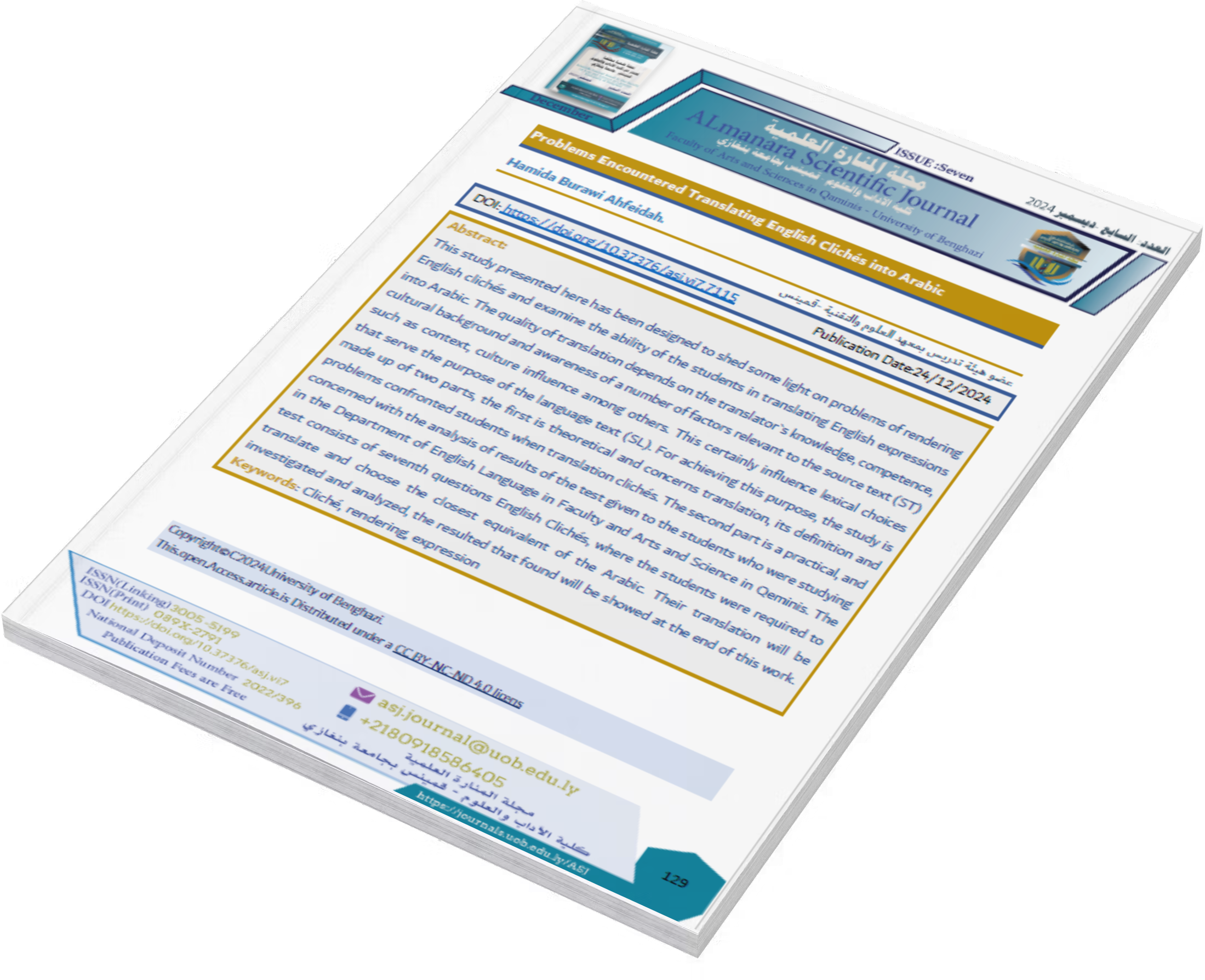Problems Encountered Translating English Clichés into Arabic
DOI:
https://doi.org/10.37376/asj.vi7.7115Keywords:
Cliché, rendering, expressionAbstract
This study presented here has been designed to shed some light on problems of rendering English clichés and examine the ability of the students in translating English expressions into Arabic. The quality of translation depends on the translator`s knowledge, competence, cultural background and awareness of a number of factors relevant to the source text (ST) such as context, culture influence among others. This certainly influence lexical choices that serve the purpose of the language text (SL). For achieving this purpose, the study is made up of two parts, the first is theoretical and concerns translation, its definition and problems confronted students when translation clichés. The second part is a practical, and concerned with the analysis of results of the test given to the students who were studying in the Department of English Language in Faculty and Arts and Science in Qeminis. The test consists of seventh questions English Clichés, where the students were required to translate and choose the closest equivalent of the Arabic. Their translation will be investigated and analyzed, the resulted that found will be showed at the end of this work
Downloads
References
Mona, B. (1992). In Other Words, A coursebook on translation. London, NY: Routledge.
Bakella, M. (1984). Arabic Culture. London: Kegan Paul International Newmark, P. (1985). The translation of metaphor. The ubiquity of metaphor: Metaphor in language and thought, 295-326.
Neubert, A., & Shreve, G. M. (1992). Translation as text (No. 1). Kent State University Press.
Catford, J . C. (1965). A Linguistic Theory of Translation. Oxford: University Press.
Aziz, Y . and Lataiwish , M.(2000) principals of translation .Benghazi : Dar Al-kutub Al –Wataneyyah.
Bassnet , S. (1991) Translation Studies . London: Routledge.
Kaushik, N. (2017, September 28). Difference Between Cliché and Idiom. Difference Between Similar Terms and Objects.
http://www.differencebetween.net/language/difference-between-cliche-and-idiom/
Kaushik, Nimisha. "Difference Between Cliché and Idiom." Difference Between Similar Terms and Objects, 28 September, 2017,
http://www.differencebetween.net/language/difference-between-cliche-and-idiom/.
Paul Cook and Graeme Hirst. 2013. Automatically assessing whether a text is cliched, with applications ´ to literary analysis. In Proceedings of the 9th Workshop on Multiword Expressions, pages 52–57
Nattinger, J.R. & De Carrico, J.S. Lexical Phrases and Language Teaching.Oxford: OUP, 1992/2009. Print. Oxford Dictionary of Idioms. Oxford: Oxford University Press, 2000. Print.
Catford, J. C. (1965). A linguistic theory of translation. London: Oxford University Press.
Savory, T. (1968). The art of translation. London: Jonathan Cape Ltd.
Newmark, P. (1981). Approaches to translation. Oxford: Oxford University

Downloads
Published
How to Cite
Issue
Section
License
Copyright (c) 2024 Almanara Scientific Journal

This work is licensed under a Creative Commons Attribution-NonCommercial-NoDerivatives 4.0 International License.







